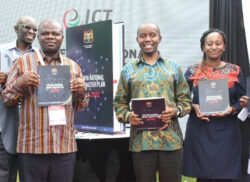
Just as road expansion and construction aims at enhancing transport, easing congestion and opening up remote areas for habitation and investment, ICT infrastructure enhances connectivity and drives our country more towards equitable distribution of broadband across the country, ultimately connecting Kenya to the rest of the world.
Through the Ministry of ICT, Innovation and Youth Affairs, the Kenyan government managed to develop a ten-year Kenya National Digital Masterplan [2022-2032] to guide the country forward on ICT deployments and investments. This Masterplan was officially launched during the 11th Connected Summit in Diani, Kwale County.
This Masterplan outlines a structured roadmap on the delivery of ICT Infrastructure and Services as well as the development of ICT skills. It will also provide guidance on investment priorities to both local and external investors.
Cabinet Secretary, Joe Mucheru urged delegates of the conference to share their insights and ideas on the various way in which ow ICT can accelerate the country’s national development agenda.
Through deliberate forums, Kenya can continue to shape the national dialogue toward a desired ICT-centric future that will not only attract investment, but also entice citizens to appreciate the relevance of ICT technology as a critical infrastructure.
The National Digital Master Plan is expected to play a pivotal role in economic development. It has identified 19 flagship projects, which the government will focus on, to accelerate digital transformation of the country. These projects are:
- The reduction of the digital divide to spur economic growth of rural areas. The masterplan proposes deployment of 100,000 Kms of fibre optic infrastructure to 40,000 schools and other learning institutions, 20,000 government institutions, 13,000 health facilities, 25,000 hotspots to support youth and innovators and establishment of 1,450 wards digital innovation hubs.
- To enable ‘one-stop shop’ for all government core services the masterplan proposes accelerated automation and digitisation for all government core services in both national and county governments. This will start with the digitisation of over 5 billion government records.
- To accelerate growth of e-commerce initiatives the masterplan is proposing implementation of the National Physical addressing system and the National Spatial Data Infrastructure to promote the growth of e-commerce and private enterprise, the Master Plan.
- To create job opportunities for the youth and spur local manufacturing and growth of SMEs. The Master Plan proposes establishment of two software factories and another two electronic manufacturing factory that will service Kenya and the region. It is estimated that these two factories will hire over 10,000 software engineers among others.
- To enable the citizen and public servants to effectively utilise technology in their businesses and work. The masterplan proposes digital literacy capacity building for all citizen starting with 20 million citizens, training of 300,000 public servants and build adequate technical support through training of 10,000 ICT professionals.
- To position the country as a Regional ICT hub. The masterplan proposes establishment of regional ICT Smart hub as well as regional submarine cables maintenance depot.
- To address country’s e-waste challenges. The masterplan proposes e-waste management programme with gives strategic focus on e-waste production, handling and disposal.
- To promote cloud services and data management for the country. The masterplan proposes accelerated implementation of Konza Techno polis and data protection legislations.
- To promote local innovators, entrepreneurs and businesses. The masterplan proposes harmonisation of legislations to enable growth of ICT businesses in addition to hosting annual international ICT Expo for entrepreneurs to show case on their products and services
- To mobilise adequate resources for successful implementation of the flagship projects. The masterplan proposes enactment of e-government legislations in addition to structured partnership with private sector and development partners.
